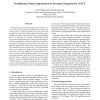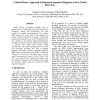150 search results - page 8 / 30 » Parallel Generation of Pseudo-Random Sequences |
BMCBI
2005
13 years 7 months ago
2005
Background: Expressed Sequence Tags (ESTs) are short and error-prone DNA sequences generated from the 5' and 3' ends of randomly selected cDNA clones. They provide an im...
TACAS
1997
Springer
13 years 11 months ago
1997
Springer
This paper describes a compositional approach to generate the labeled transition system representing the behavior of a Lotos program by repeatedly alternating composition and reduc...
WIA
2000
Springer
13 years 11 months ago
2000
Springer
Abstract. In 6], G. Myers describes a bit-vector algorithm to compute the edit distance between strings. The algorithm converts an input sequence to an output sequence in a paralle...
ICPR
2004
IEEE
14 years 8 months ago
2004
IEEE
The front end of many motion analysis algorithms is usually a process that generates bounding boxes around each moving object, roughly segmenting the objects from the background. ...
EDOC
2008
IEEE
13 years 9 months ago
2008
IEEE
Model Driven Development (MDD) aims to promote the role of modeling in Software Engineering. Enterprise systems and architectures are often modeled via multiple representations. F...


